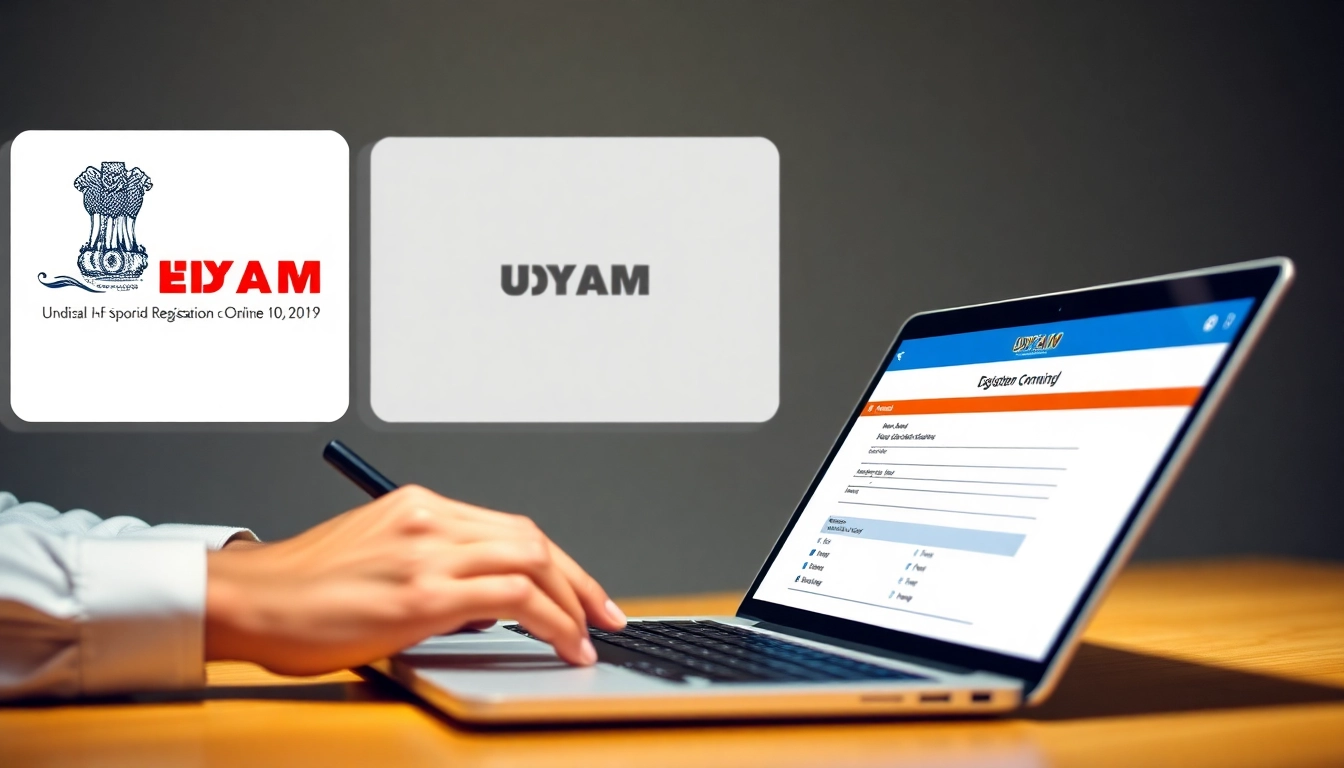Introduction to Udyam Registration and Its Significance
In India’s rapidly evolving economic landscape, entrepreneurship and small to medium enterprises play a pivotal role in fostering innovation, employment, and economic growth. Recognizing this, the Government of India introduced the udyam registration system as an official gateway for MSMEs to formalize their operations. This registration simplifies access to government schemes, financial benefits, and essential business services. It acts as a foundational step for entrepreneurs aiming to establish, expand, or legitimize their enterprises, aligning their business processes with national standards and regulatory requirements.
Understanding the significance of udyam registration is crucial for entrepreneurs at all stages—from startups to established MSMEs. It not only enhances credibility but also enables access to a host of benefits like subsidized loans, government procurement opportunities, and tax exemptions, making it an indispensable tool for sustainable business growth. This comprehensive guide delves into every aspect of the udyam registration process, ensuring that entrepreneurs are well-equipped to navigate the system effectively.
What is Udyam Registration?
Udyam Registration is a government-initiated online registration process introduced by the Ministry of Micro, Small, and Medium Enterprises (MSME) in India. It is designed to create a unified platform for MSME registration, replacing older systems such as the Udyog Aadhar registration. The registration process involves submitting basic business details, ownership information, and relevant documents to obtain a unique Udyam Registration Number (URN).
This registration is more than just a formal process; it classifies and categorizes MSMEs depending on their investment and turnover metrics, enabling both the government and entrepreneurs to access tailored benefits. The system is fully digital, user-friendly, and aims to streamline the registration process, making it accessible to entrepreneurs across diverse sectors and regions.
Benefits for MSMEs and Entrepreneurs
The Udyam Registration confers numerous advantages that significantly impact the growth trajectory of MSMEs in India. Some of the key benefits include:
- Access to Government Schemes: Registered MSMEs Gain eligibility for various subsidy schemes, grants, and preferential procurement policies under central and state governments.
- Financial Incentives: Facilitation in availing bank loans at concessional rates, credit guarantee schemes, and easier collateral-free financing options.
- Tax Benefits: Potential exemptions and reliefs, especially for newly registered or micro-enterprises qualifying under specific thresholds.
- Market Credibility: Enhanced reputation among suppliers, customers, and financial institutions due to formal registration.
- Simplified Compliance: Easier adherence to legal and regulatory requirements, reducing the risk of penalties or disputes.
- Business Expansion and Opportunities: Udyam registration makes your enterprise eligible for government tenders, export incentives, and integration into MSME clusters.
- Digital Support and Monitoring: Online dashboard access for tracking benefits, compliance, and renewal statuses ensures ongoing engagement with government programs.
In sum, Udyam Registration acts as a catalyst, enhancing transparency, trust, and operational efficiency for MSMEs aiming to thrive in competitive markets.
Difference Between Udyog Aadhar and Udyam
Initially, the government introduced the Udyog Aadhar (or Udyog Aadhaar) registration as a means for MSMEs to formalize their operations. However, with evolving policy frameworks, Udyam Registration was launched to streamline and unify the registration process under a single platform. Here are the key distinctions:
- Terminology & Recognition: Udyog Aadhar was a simple self-declaration-based registration, whereas Udyam Registration is a comprehensive, digitally managed process providing a unique identification number and classification.
- Registration Process: Udyog Aadhar involved minimal documentation, often leading to issues of duplicate entries, while Udyam Registration requires specific details, including PAN, Aadhaar, and enterprise investment metrics.
- Regulatory Oversight: Udyam Registration falls under the direct oversight of the Ministry of MSME, leading to better integration with national policies and benefits.
- Validity and Renewal: Udyog Aadhar lacked a formal renewal mechanism, whereas Udyam Registration is valid for up to four years and requires regular updates and re-registration.
- Benefits & Recognition: The Udyam platform offers enhanced benefits, including access to various government schemes, which were more limited under Udyog Aadhar.
Moving from Udyog Aadhar to Udyam registration ensures a more reliable, efficient, and beneficial registration experience, aligning MSMEs with current government policies.
Step-by-Step Udyam Registration Process
Preparing Required Documents
Before initiating the Udyam registration, ensure you have the following documents ready:
- Aadhaar Number: The primary identity proof for the entrepreneur.
- Business PAN Card: For tax and financial identification.
- Proof of Business Address: Such as utility bills, rent agreement, or shop establishment license.
- Bank Details: Including bank account number and IFSC code.
- Investment Details: Information on the investment in plant and machinery or equipment.
- Ownership Details: Personal identification and business ownership proof.
Having these documents scanned or available digitally will streamline the online application process and reduce possible delays.
Filling Out the Online Registration Form
The registration process involves visiting the official Udyam Registration portal (https://udyamregistration.gov.in/), where you will undertake the following steps:
- Navigate to the portal and select “New Registration”.
- Enter your Aadhaar number, which is linked to your digital identity.
- Fill in personal details: Name, address, contact details, and email.
- Provide business-related information: Type of organization, PAN number, enterprise investment details, and business activity.
- Review and verify all information entered before submission.
- Submit the form and receive a registration acknowledgment with your Udyam Registration Number.
Annexing or verifying your documents online during registration ensures transparency and correctness of data, facilitating smooth approval.
Submitting and Verifying Your Application
After completing the form, the system does a real-time verification using Aadhaar and other linked details. Upon successful verification:
- You receive a digitally signed Udyam Registration Certificate, which is proof of your MSME status.
- You can download and print this certificate for official and business purposes.
If there are discrepancies or technical issues, the portal provides support and assistance, ensuring that entrepreneurs do not face insurmountable hurdles during registration.
Common Challenges and How to Overcome Them
Updating and Re-Registering Your MSME Certificate
Periodic updates are essential to keep your Udyam registration active. In case of changes in business details, ownership, or address, re-registrations can be completed via the portal. The process involves accessing the “Update” section, submitting new documents if needed, and verifying the changes.
Failing to update details may result in the suspension or invalidity of benefits linked to MSME status, thus, timely updates are critical.
Migration from Udyog Aadhar to Udyam
Businesses registered under Udyog Aadhar can migrate seamlessly to Udyam Registration by visiting the portal, selecting the migration option, and entering their existing Udyog Aadhar number and other details. This transition is crucial for continued benefits and recognition, and the portal provides clear guidance to facilitate the migration.
Technical Issues and Support Resources
While the portal is designed for ease of use, technical glitches or navigation issues can occasionally arise. Entrepreneurs are advised to:
- Clear cache and update browsers regularly.
- Use supported browsers like Chrome or Firefox.
- Contact support through helplines or email provided on the portal.
- Refer to detailed user manuals and FAQs available online for troubleshooting.
Proactively engaging with support channels ensures minimal disruption and timely resolution of issues.
Maximizing Benefits from Your Udyam Certificate
Accessing Loans, Subsidies, and Incentives
One of the primary advantages of Udyam Registration is unlocking financial benefits. Banks and financial institutions recognize registered MSMEs more readily, simplifying loan approvals, especially for working capital and expansion funding. Furthermore, government schemes like subsidies on technology upgrades or export incentives are accessible to registered enterprises.
Entrepreneurs should regularly monitor government portals and their Udyam dashboard to stay updated on available schemes, deadlines, or new benefits introduced.
Using Udyam Details for Business Expansion
Udyam registration acts as a formal endorsement of your enterprise, making it eligible for participation in government tenders and bulk procurement programs. It can also facilitate export opportunities through certifications and support services.
Business owners are encouraged to link their Udyam registration with other digital platforms, such as GST registration, digital payment systems, and export portals to streamline operations and leverage collective benefits.
Monitoring and Maintaining Your MSME Status
Continuous compliance requires regular updating of business details and renewal of registration. Staying proactive ensures uninterrupted benefits, maintaining credibility and access to government schemes. Using online dashboards, entrepreneurs can track status, upcoming deadlines, and eligibility for new schemes.
Engaging with local MSME associations and attending government workshops can also enhance awareness of new benefits and compliance requirements.
Latest Regulations and Future Outlook
Government Initiatives for MSMEs
The government remains committed to strengthening MSMEs through various initiatives like the Make in India campaign, technology incubation centers, and digital payment drives. Udyam Registration is expected to evolve with features like integration with GST, income tax, and export database systems, creating a holistic support ecosystem.
Moreover, MSMEs are encouraged to adopt advanced technologies, digital marketing, and sustainable practices to stay competitive and aligned with government policy directions.
Updates in Udyam Registration Policies
Recent updates have focused on simplifying the re-registration process, enhancing portal security, and expanding coverage to inclusion of service providers and startups. Going forward, digital integration with banking and financial systems is likely to streamline fund flow and benefit tracking.
Stakeholders should stay engaged with official portals and MSME policy updates for timely information and compliance adherence.
Tips for Sustained Business Growth
Sustained growth hinges on leveraging registration benefits, continuous skill development, adopting innovative technologies, and maintaining transparency with government schemes. Regular data audits, proactive compliance, and strategic planning can transform MSMEs into competitive industry players.














